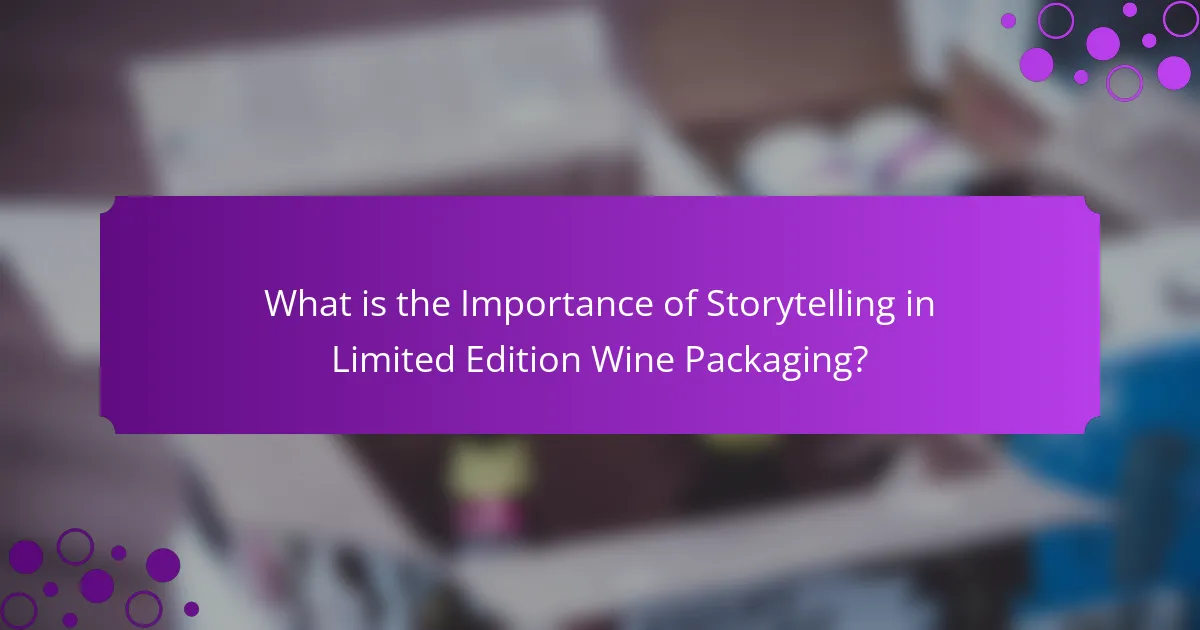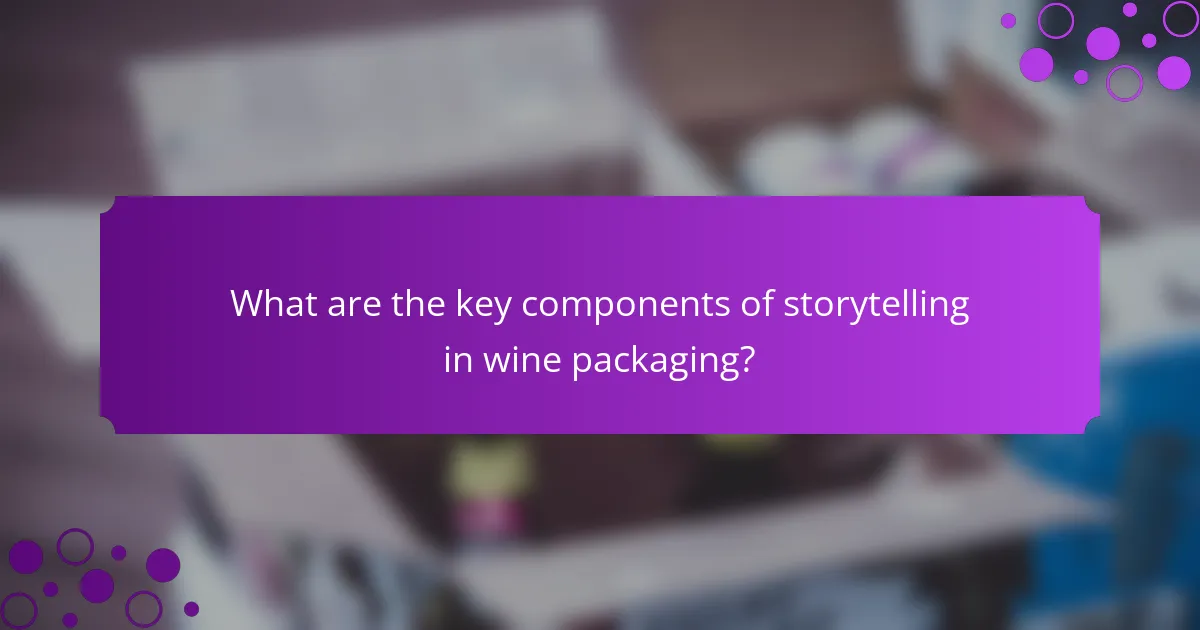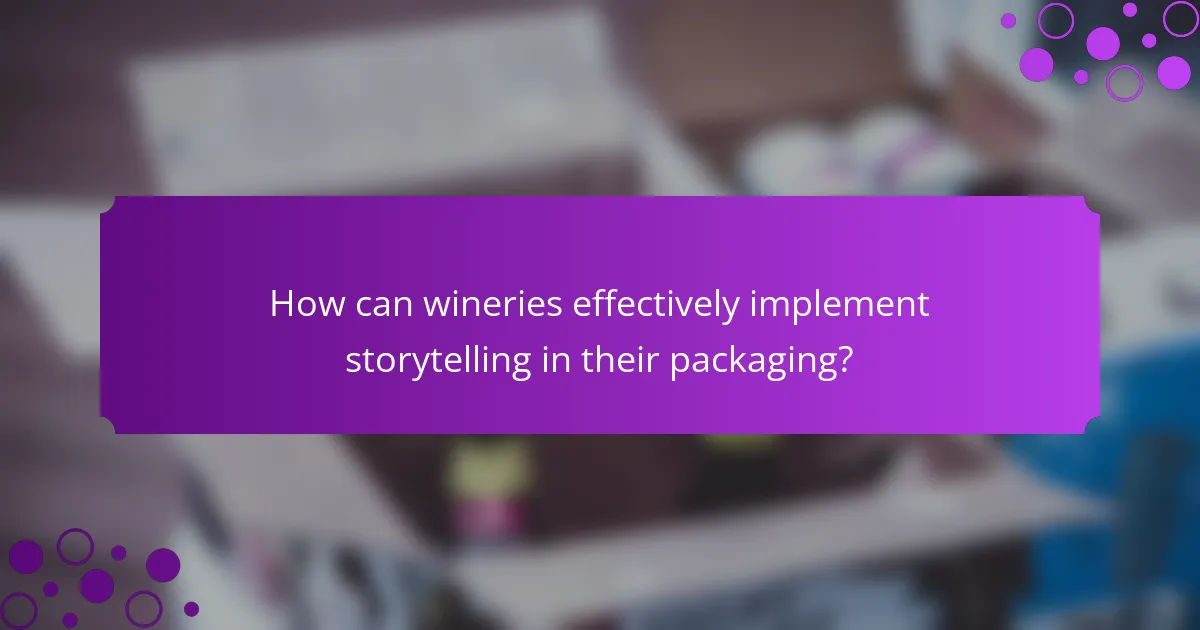
What is the Importance of Storytelling in Limited Edition Wine Packaging?
Storytelling in limited edition wine packaging is crucial for creating emotional connections with consumers. It enhances the perceived value of the wine by providing a narrative that resonates with buyers. This narrative often includes the history of the vineyard, the winemaking process, or the inspiration behind the wine. By incorporating storytelling, brands differentiate themselves in a competitive market. This approach can lead to increased customer loyalty and repeat purchases. Research indicates that products with compelling stories can command higher prices. For example, studies show that consumers are willing to pay up to 20% more for products with engaging narratives. Thus, storytelling significantly impacts consumer perception and purchasing behavior in the wine industry.
How does storytelling enhance the appeal of limited edition wine packaging?
Storytelling enhances the appeal of limited edition wine packaging by creating an emotional connection with consumers. This connection makes the product more memorable and desirable. When a wine brand shares its story, it adds depth to the experience. Consumers are more likely to purchase products that resonate with them personally. For example, stories about the vineyard’s heritage or winemaking process can evoke feelings of authenticity. Research shows that emotional branding can increase customer loyalty by 23%. Additionally, unique narratives can differentiate a brand in a crowded market. This differentiation is crucial for limited edition products, which rely on exclusivity and uniqueness to attract buyers.
What elements of storytelling are most effective in wine packaging?
Effective storytelling elements in wine packaging include narrative, visuals, and authenticity. A compelling narrative communicates the origin and inspiration behind the wine. This engages consumers emotionally, making them feel connected to the product. Visual elements like labels and colors enhance the story and attract attention on shelves. Authenticity is crucial; consumers prefer brands that share genuine stories about their heritage or production process. Research indicates that storytelling can increase consumer willingness to pay by up to 20%. This demonstrates the tangible impact of effective storytelling in wine packaging.
How do consumers respond to storytelling in wine packaging?
Consumers respond positively to storytelling in wine packaging. Storytelling enhances emotional connections to the product. It provides context and meaning, increasing consumer engagement. Research shows that narratives can influence purchasing decisions. A study by the Journal of Consumer Research found that storytelling can elevate perceived value. Consumers are more likely to remember brands that use storytelling effectively. This leads to increased brand loyalty and repeat purchases. Overall, storytelling in wine packaging creates a memorable consumer experience.
Why is storytelling crucial for branding in the wine industry?
Storytelling is crucial for branding in the wine industry because it creates emotional connections with consumers. These narratives enhance brand identity and differentiate products in a crowded market. A compelling story can convey the heritage, craftsmanship, and unique attributes of a wine. For example, a winery’s tale of its founding can evoke a sense of authenticity. This emotional engagement can drive consumer loyalty and preference. Research shows that brands with strong narratives can see up to a 20% increase in sales. Storytelling also fosters a sense of community among wine enthusiasts, enhancing brand visibility.
What role does storytelling play in differentiating wine brands?
Storytelling plays a crucial role in differentiating wine brands. It creates a unique narrative that resonates with consumers. This narrative can include the history of the vineyard, the winemaking process, or the inspiration behind a specific wine. Engaging stories help build emotional connections with consumers. According to a study by the Wine Market Council, consumers are more likely to choose wines with compelling stories. Brands that effectively communicate their stories often see increased brand loyalty. This differentiation can lead to higher perceived value among consumers. Ultimately, storytelling enhances the overall brand experience in the competitive wine market.
How can storytelling influence consumer loyalty in the wine market?
Storytelling can significantly influence consumer loyalty in the wine market. It creates an emotional connection between the brand and the consumer. This connection fosters trust and attachment to the brand. Engaging narratives about the origin, production process, or vineyard history enhance the perceived value of the wine. Consumers are more likely to remain loyal to brands that resonate with their values and experiences. Research shows that brands with compelling stories can increase customer retention rates by up to 55%. By sharing unique stories, wineries differentiate themselves in a crowded market. This differentiation leads to repeat purchases and brand advocacy among consumers.

What are the key components of storytelling in wine packaging?
The key components of storytelling in wine packaging include narrative, design, authenticity, and emotional connection. Narrative conveys the history and inspiration behind the wine. Design reflects the brand’s identity and enhances the visual appeal. Authenticity ensures the story aligns with the wine’s origin and production process. Emotional connection engages consumers, fostering loyalty and interest. These components work together to create a compelling story that resonates with consumers, ultimately influencing their purchasing decisions.
How can the wine’s origin enhance its storytelling?
The wine’s origin enhances its storytelling by providing a unique context and history. Each wine region has distinct characteristics influenced by climate, soil, and tradition. For example, Bordeaux wines are known for their rich history and prestigious classification system. This regional identity adds depth to the narrative surrounding the wine. Additionally, specific vineyards often have unique stories tied to their land and winemaking practices. These elements create a more engaging experience for consumers. The storytelling aspect can significantly influence purchasing decisions, as buyers are drawn to the heritage and authenticity of the product.
What historical or cultural narratives can be included in wine packaging?
Historical or cultural narratives included in wine packaging can enhance consumer connection. These narratives often reflect the region’s heritage. For example, stories of ancient winemaking techniques can be featured. Local legends or folklore associated with vineyards can also be included. Additionally, historical events that shaped wine production in a region can be highlighted. Cultural practices related to wine, such as traditional harvest festivals, can be depicted. The influence of specific grape varieties on local culture can be presented. These narratives create a richer context for the wine, making it more appealing to consumers.
How does the winemaking process contribute to the story of the wine?
The winemaking process shapes the narrative of the wine by influencing its flavor, aroma, and character. Each step, from grape selection to fermentation, tells a unique story. For instance, the choice of grape variety directly impacts the wine’s taste profile. The terroir, or environmental factors, also plays a crucial role in defining the wine’s identity. Fermentation techniques can enhance specific characteristics, adding depth to the wine’s story. Aging in different types of barrels further contributes to flavor complexity. This intricate process creates a connection between the wine and its origin. Ultimately, the winemaking process encapsulates the traditions and innovations of the winemaker, enriching the overall narrative.
What visual elements support storytelling in limited edition wine packaging?
Visual elements that support storytelling in limited edition wine packaging include illustrations, typography, and color schemes. Illustrations can depict the vineyard’s history or the winemaking process. Typography conveys the brand’s personality and can evoke emotions. Color schemes often reflect the wine’s flavor profile or origin. These elements create a cohesive narrative that enhances consumer engagement. Research indicates that packaging design significantly influences purchasing decisions, with 70% of consumers making choices based on visual appeal.
How do colors and graphics convey the wine’s story?
Colors and graphics convey the wine’s story by visually representing its origin, flavor profile, and brand identity. For example, earthy tones may suggest a rustic vineyard, while vibrant colors can imply bold flavors. Graphics such as illustrations or logos further enhance the narrative by connecting the consumer to the wine’s heritage. Specific imagery can evoke emotions or memories associated with the wine. Research indicates that consumers often make purchasing decisions based on packaging design. A study by the Journal of Wine Research found that attractive labels significantly influence consumer choice. Therefore, effective use of colors and graphics not only communicates the wine’s story but also drives sales.
What role does typography play in storytelling on wine labels?
Typography plays a crucial role in storytelling on wine labels. It conveys the brand’s identity and the wine’s characteristics. Different fonts evoke various emotions and perceptions. For example, elegant scripts suggest sophistication, while bold sans-serifs indicate modernity. Typography also aids in readability, ensuring consumers can easily identify key information. The arrangement of text can guide the viewer’s eye and create a narrative flow. Wine labels often use typography to reflect the region or heritage of the wine. This connection enhances the consumer’s experience and understanding of the product. Overall, effective typography transforms a simple label into a compelling story.

How can wineries effectively implement storytelling in their packaging?
Wineries can effectively implement storytelling in their packaging by incorporating visual and textual elements that reflect their brand narrative. This includes using labels that showcase the vineyard’s history, terroir, and winemaking process. Engaging graphics and imagery can evoke emotions and connect consumers to the product’s origin. Textual storytelling, such as anecdotes or descriptions of the wine’s creation, can enhance the consumer’s experience. Research shows that consumers are more likely to purchase products with compelling narratives, as it fosters a sense of connection. For example, a study by the Journal of Marketing found that storytelling can increase customer engagement and brand loyalty. By integrating these elements, wineries can create a memorable packaging experience that resonates with consumers.
What strategies can wineries use to craft compelling narratives?
Wineries can craft compelling narratives by focusing on their unique heritage and the story behind their wines. They should highlight the history of the vineyard, including its founding and the family traditions involved. Emphasizing the specific terroir can create a deeper connection to the land and its influence on the wine’s flavor.
Utilizing sensory descriptions enhances the narrative by allowing consumers to imagine the taste, aroma, and experience of the wine. Engaging storytelling can include anecdotes about the winemaking process, such as challenges faced or innovative techniques used.
Incorporating customer stories or testimonials adds authenticity and relatability to the narrative. Wineries can also leverage visual storytelling through packaging design that reflects the narrative, enhancing the overall consumer experience.
Research indicates that brands with compelling stories can drive consumer loyalty and increase sales. A study by the Harvard Business Review found that storytelling can significantly influence purchasing decisions.
How can wineries involve consumers in the storytelling process?
Wineries can involve consumers in the storytelling process by encouraging participation in vineyard tours and tastings. These experiences allow consumers to learn about the wine-making process firsthand. Additionally, wineries can invite consumers to share their personal stories related to wine through social media campaigns. This engagement fosters a sense of community and connection to the brand. Wineries can also create interactive labeling that prompts consumers to scan QR codes for more in-depth stories about the wine. Such initiatives enhance consumer involvement and deepen their appreciation for the product. Studies show that storytelling increases consumer loyalty and emotional attachment to brands. By integrating these strategies, wineries can effectively engage consumers in their storytelling.
What are some examples of successful storytelling in wine packaging?
Successful storytelling in wine packaging includes brands that create narratives around their products. One example is the “19 Crimes” wine, which features labels with real-life criminals’ stories. Each bottle tells a unique tale of a historical figure, enhancing consumer engagement. Another example is “The Prisoner” wine, which uses a narrative about breaking free from conventions. Its packaging reflects themes of rebellion and individuality. “Chateau Mouton Rothschild” incorporates artwork from famous artists on its labels, each telling a story about the vintage. These storytelling techniques create emotional connections with consumers, making the wines memorable and distinctive.
What best practices should wineries follow for storytelling in packaging?
Wineries should focus on authenticity, clarity, and visual appeal in storytelling through packaging. Authenticity involves conveying the true essence of the wine’s origin and production process. Clarity ensures that the story is easily understood by consumers. Visual appeal captures attention and creates an emotional connection.
Incorporating local culture and heritage into the design can enhance relatability. Using high-quality materials reflects the wine’s value and craftsmanship. Engaging narratives on labels can intrigue consumers and encourage them to explore the wine further.
Research indicates that storytelling can increase consumer engagement and brand loyalty. A study by the Journal of Wine Research found that storytelling positively impacts purchase intentions. By following these best practices, wineries can effectively communicate their unique stories through packaging.
How can wineries balance storytelling with regulatory requirements?
Wineries can balance storytelling with regulatory requirements by integrating compliance into their narrative strategies. They should ensure that all claims about their wines are truthful and substantiated, adhering to guidelines set by organizations like the Alcohol and Tobacco Tax and Trade Bureau (TTB). This includes accurately representing the origin, varietal, and production methods. Wineries can focus on storytelling elements that highlight the heritage and craftsmanship without making unverifiable claims. For instance, they can emphasize traditional winemaking techniques or local terroir, which are compliant with regulations. Engaging consumers through authentic narratives enhances brand loyalty while respecting legal standards. By aligning their stories with factual information, wineries can effectively marry creativity with compliance.
What tips can enhance the effectiveness of storytelling in wine packaging?
Use clear and engaging narratives to enhance storytelling in wine packaging. Focus on the origin of the grapes, as this builds authenticity. Highlight winemaking techniques to connect consumers with the craftsmanship involved. Incorporate visual elements that reflect the story, such as illustrations or photographs. Utilize descriptive language that evokes sensory experiences related to the wine. Share personal anecdotes or historical facts that resonate with the target audience. Create a cohesive brand message that aligns with the story being told. Employ limited edition labels to emphasize exclusivity and create a sense of urgency.
The main entity of this article is storytelling in limited edition wine packaging. The article emphasizes the significance of storytelling in enhancing emotional connections with consumers, increasing perceived value, and fostering brand loyalty in the wine industry. It explores effective storytelling elements such as narrative, visuals, and authenticity, and discusses how these components can differentiate brands in a competitive market. Additionally, it highlights the impact of storytelling on consumer purchasing behavior and loyalty, providing insights into best practices for wineries to effectively implement storytelling in their packaging.